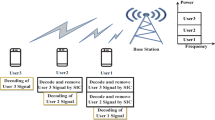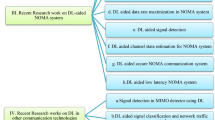Abstract
Orthogonal frequency division multiplexing (OFDM), one of the most dominant technology for fifth-generation (5G) wireless communication systems offers a high data rate with better spectrum efficiency. However, OFDM based systems suffer from various channel imperfections such as channel distortion, carrier frequency offset (CFO) due to transceiver local oscillator frequency mismatch, sampling frequency offset (SFO) between DAC/ADCs, nonlinear distortion (NLD) due to the nonlinear power amplifier, and fading caused by frequency selective channels. Recently OFDM based non-orthogonal multiple access (NOMA) scheme is attracting researchers’ attraction owing to its high spectral efficiency, massive connectivity, and resilience to frequency selectivity for the upcoming 5G wireless communication and beyond. However, NOMA-OFDM systems suffer the same demerits as OFDM-based systems to deploy such a multicarrier system for 5G and beyond applications. This paper studies the problem of various channel imperfections on OFDM and OFDM-NOMA systems and proposes machine learning (ML) based estimation and signal detection for OFDM and NOMA-OFDM based systems in presence of the aforementioned channel imperfections. Various ML models like neural network (NN), Recurrent-NN, long-short-term-memory are adopted in this research for channel estimation-equalization, CFO-SFO estimation and compensation and mitigation of NLD in OFDM and NOMA-OFDM receiver. Extensive simulation studies show that the ML-based techniques outperform traditional LS, MMSE-based methods for OFDM receiver, and LS-SIC, MMSE-SIC based methods for NOMA-OFDM receiver.













Similar content being viewed by others
References
Kim, Y.-H., & Lee, J.-H. (2011). Joint maximum likelihood estimation of carrier and sampling frequency offsets for OFDM systems. IEEE Transactions on Broadcasting, 57(2), 277–283. https://doi.org/10.1109/TBC.2011.2122890.
Merchan, S., Armada, A. G., & Garcia, J. L. (1998). OFDM performance in amplifier nonlinearity. IEEE Transactions on Broadcasting, 44(1), 106–114. https://doi.org/10.1109/11.713060.
Speth, M., Fechtel, S. A., Fock, G., & Meyr, H. (1999). Optimum receiver design for wireless broad-band systems using OFDM. I. IEEE Transactions on Communications, 47(11), 1668–1677. https://doi.org/10.1109/26.803501.
Li, Y., Cimini, L. J., & Sollenberger, N. R. (1998). Robust channel estimation for OFDM systems with rapid dispersive fading channels. IEEE Transactions on Communications, 46(7), 902–915. https://doi.org/10.1109/26.701317.
Nguyen-Le, H., Le-Ngoc, T., & Ko, C. C. (2009). RLS-based joint estimation and tracking of channel response, sampling, and carrier frequency offsets for OFDM. IEEE Transactions on Broadcasting, 55(1), 84–94. https://doi.org/10.1109/TBC.2008.2012361.
Schmidl, T. M., & Cox, D. C. (1997). Robust frequency and timing synchronization for OFDM. IEEE Transactions on Communications, 45(12), 1613–1621. https://doi.org/10.1109/26.650240.
Wang, X., & Hu, B. (2014). A low-complexity ml estimator for carrier and sampling frequency offsets in OFDM systems. IEEE Communications Letters, 18(3), 503–506. https://doi.org/10.1109/LCOMM.2013.123113.132444.
Lv, T., Li, H., & Chen, J. (2005). Joint estimation of symbol timing and carrier frequency offset of OFDM signals over fast time-varying multipath channels. IEEE Transactions on Signal Processing, 53(12), 4526–4535. https://doi.org/10.1109/TSP.2005.859233.
Wang, X., & Hu, B. (2014). A low-complexity ml estimator for carrier and sampling frequency offsets in OFDM systems. IEEE Communications Letters, 18(3), 503–506. https://doi.org/10.1109/LCOMM.2013.123113.132444.
Meng, Y., Zhang, W., Stüber, G. L., & Wang, W. (2020). Blind Fast CFO Estimation and Performance Analysis for OFDM. IEEE Transactions on Vehicular Technology, 69(10), 11501–11514. https://doi.org/10.1109/TVT.2020.3012968.
Huang, D., & Letaief, K. B. (2005). An interference-cancellation scheme for carrier frequency offsets correction in OFDMA systems. IEEE Transactions on Communications, 53(7), 1155–1165. https://doi.org/10.1109/TCOMM.2005.851558.
Balachander, T., & Krishnan, M. B. M. (2021). Carrier frequency offset (CFO) synchronization and peak average power ratio (PAPR) minimization for energy efficient cognitive radio network (CRN) for 5G wireless communication. Wireless Personal Communications no. 0123456789. https://doi.org/10.1007/s11277-021-08726-3.
Thota, S., Kamatham, Y., & Paidimarry, C. S. (2020). Analysis of hybrid PAPR reduction methods of OFDM Signal for HPA models in wireless communications. IEEE Access, 8, 22780–22791. https://doi.org/10.1109/ACCESS.2020.2970022.
Hilario-Tacuri, A., Maldonado, J., Revollo, M., & Chambi, H. (2021). Bit error rate analysis of NOMA-OFDM in 5G systems with non-linear HPA with memory. IEEE Access, 9, 83709–83717. https://doi.org/10.1109/ACCESS.2021.3087536.
Singya, P. K., Kumar, N., & Bhatia, V. (2017). Mitigating NLD for wireless networks: effect of nonlinear power amplifiers on future wireless communication networks. IEEE Microwave Magazine, 18(5), 73–90. https://doi.org/10.1109/MMM.2017.2691423.
Komatsu, K., Miyaji, Y., & Uehara, H. (2020). Iterative nonlinear self-interference cancellation for in-band full-duplex wireless communications under mixer imbalance and amplifier nonlinearity. IEEE Transactions on Wireless Communications, 19(7), 4424–4438. https://doi.org/10.1109/TWC.2020.2983407.
Qin, Z., Ye, H., Li, G. Y., & Juang, B.-H.F. (2019). Deep learning in physical layer communications. IEEE Wireless Communications, 26(2), 93–99. https://doi.org/10.1109/MWC.2019.1800601.
Hu, Q., Gao, F., Zhang, H., Jin, S., & Li, G. Y. (2021). Deep learning for channel estimation: Interpretation, performance, and comparison. IEEE Transactions on Wireless Communications, 20(4), 2398–2412. https://doi.org/10.1109/TWC.2020.3042074.
Liu, J., Mei, K., Zhang, X., Ma, D., & Wei, J. (2019). Online extreme learning machine-based channel estimation and equalization for OFDM systems. IEEE Communications Letters, 23(7), 1276–1279. https://doi.org/10.1109/LCOMM.2019.2916797.
Ye, H., Li, G. Y., & Juang, B.-H. (2018). Power of deep learning for channel estimation and signal detection in OFDM systems. IEEE Wireless Communications Letters, 7(1), 114–117. https://doi.org/10.1109/LWC.2017.2757490.
Soltani, M., Pourahmadi, V., Mirzaei, A., & Sheikhzadeh, H. (2019). Deep learning-based channel estimation. IEEE Communications Letters, 23(4), 652–655. https://doi.org/10.1109/LCOMM.2019.2898944.
Emir, A., Kara, F., Kaya, H., & Li, X. (2021). Deep learning-based flexible joint channel estimation and signal detection of multi-user OFDM-NOMA. Physics Communications, 48, 101443. https://doi.org/10.1016/j.phycom.2021.101443.
Luo, C., Ji, J., Wang, Q., Chen, X., & Li, P. (2020). Channel state information prediction for 5G wireless communications: A deep learning approach. IEEE Transactions on Network Science and Engineering, 7(1), 227–236. https://doi.org/10.1109/TNSE.2018.2848960.
A General Architecture for Behavior Modeling of Nonlinear Power Amplifier using Deep Convolutional Neural Network. (2020).
Khawam, Y., Hammi, O., Albasha, L., & Mir, H. (2020). Behavioral modeling of GaN doherty power amplifiers using memoryless polar domain functions and deep neural networks. IEEE Access, 8, 202707–202715. https://doi.org/10.1109/ACCESS.2020.3036186.
Kumar, A., Saha, S., Abhiranjan & Bhattacharya, R. (2020). Neural network based joint carrier frequency offset and sampling frequency offset estimation and compensation in MIMO OFDM-OQAM systems. In XXXIIIrd general assembly and scientific symposium of the international union of radio science (pp. 1–4).https://doi.org/10.23919/URSIGASS49373.2020.9232207.
Xie, Y., Teh, K. C., & Kot, A. C. (2021). Deep learning-based joint detection for OFDM-NOMA scheme. IEEE Communications Letters, 25(8), 2609–2613. https://doi.org/10.1109/LCOMM.2021.3077878.
Dutta, A. K. (2019). MBER criterion assisted power NOMA design and performance analysis with estimated channel. IEEE Transactions on Vehicular Technology, 68(12), 11816–11826. https://doi.org/10.1109/TVT.2019.2944767.
Kazemian, M., Abouei, J., & Anpalagan, A. (2021). A low complexity enhanced-NOMA scheme to reduce inter-user interference, BER and PAPR in 5G wireless systems. Physics Communications, 48, 101412. https://doi.org/10.1016/j.phycom.2021.101412.
Ganji, M., Zou, X., & Jafarkhani, H. (2021). Asynchronous transmission for multiple access channels: Rate-region analysis and system design for uplink NOMA. IEEE Transactions on Wireless Communications, 20(7), 4364–4378. https://doi.org/10.1109/TWC.2021.3058405.
Wang, X., Zhu, P., Li, D., Xu, Y., & You, X. (2021). Pilot-assisted SIMO-NOMA signal detection with learnable successive interference cancellation. IEEE Communications Letters, 25(7), 2385–2389. https://doi.org/10.1109/LCOMM.2021.3070705.
Alsmadi, M. M., Ali, N. A., Hayajneh, M., & Ikki, S. S. (2020). Down-Link NOMA networks in the presence of IQI and imperfect SIC: Receiver design and performance analysis. IEEE Transactions on Vehicular Technology, 69(6), 6793–6797. https://doi.org/10.1109/TVT.2020.2982171.
Trivedi, V. K., Ramadan, K., Kumar, P., Dessouky, M. I., & Abd El-Samie, F. E. (2019). Enhanced OFDM-NOMA for next generation wireless communication: A study of PAPR reduction and sensitivity to CFO and estimation errors. AEU - International Journal of Electronics and Communications, 102, 9–24. https://doi.org/10.1016/j.aeue.2019.01.009.
Balogun, M. B., Takawira, F., & Oyerinde, O. O. (2019). Uplink OFDM based NOMA plagued with carrier frequency offset errors. In IEEE AFRICON conference. https://doi.org/10.1109/AFRICON46755.2019.9133906.
Panchal, A., & Dutta, A. K. (2021). Performance analysis and design of MIMO power NOMA with estimated parameters error statistics along with SIC and hardware imperfections. IEEE Transactions on Vehicular Technology, 70(2), 1488–1500. https://doi.org/10.1109/TVT.2021.3053360.
Gui, G., Huang, H., Song, Y., & Sari, H. (2018). Deep learning for an effective nonorthogonal multiple access scheme. IEEE Transactions on Vehicular Technology, 67(9), 8440–8450. https://doi.org/10.1109/TVT.2018.2848294.
Lin, C., Chang, Q., & Li, X. (2019). A deep learning approach for mimo-noma downlink signal detection. Sensors (Switzerland), 19(11), 1–22. https://doi.org/10.3390/s19112526.
Ganji, M., & Jafarkhani, H. (2019). Improving NOMA multi-carrier systems with intentional frequency offsets. IEEE Wireless Communications Letters, 8(4), 1060–1063. https://doi.org/10.1109/LWC.2019.2906170.
Werbos, P. J. (1990). Backpropagation through time: What it does and how to do it. Proceedings of the IEEE, 78(10), 1550–1560. https://doi.org/10.1109/5.58337.
Hochreiter, S., & Schmidhuber, J. (1997). Long short-term memory. Neural Computation, 9(8), 1735–1780. https://doi.org/10.1162/neco.1997.9.8.1735.
Greff, K., Srivastava, R. K., Koutnik, J., Steunebrink, B. R., & Schmidhuber, J. (2017). LSTM: A search space odyssey. IEEE Transactions on Neural Networks and Learning Systems, 28(10), 2222–2232. https://doi.org/10.1109/TNNLS.2016.2582924.
Author information
Authors and Affiliations
Corresponding author
Additional information
Publisher's Note
Springer Nature remains neutral with regard to jurisdictional claims in published maps and institutional affiliations.
Rights and permissions
About this article
Cite this article
Singh, A., Saha, S. Machine/deep learning based estimation and detection in OFDM communication systems with various channel imperfections. Wireless Netw 28, 2637–2650 (2022). https://doi.org/10.1007/s11276-022-02994-y
Accepted:
Published:
Issue Date:
DOI: https://doi.org/10.1007/s11276-022-02994-y




